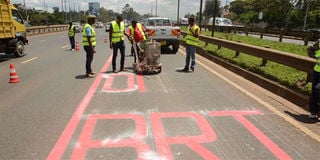Thika Road high-capacity bus lane to cost Sh5.8 billion

Workers mark a section of Thika Road ahead of the introduction of the bus rapid transit system. FILE PHOTO | NATION MEDIA GROUP
What you need to know:
- The four footbridges under construction on Thika Road are designed as modules for ease of modifications to accommodate BRT services.
- Aside from these, development of park and ride facility has been proposed at Kasarani stadium to be integrated with the commuter rail services.
Taxpayers will spend Sh5.8 billion to construct a lane for high-capacity buses along Thika Road in a bid to ease Nairobi's traffic congestion.
Transport cabinet secretary James Macharia told Parliament earlier this week the design will comprise a station, four-foot bridges as well as a park and ride facility.
The Kenya National Highways Authority (Kenha) is overseeing the project which is one of the five Bus Rapid Transport (BRT) System corridors in Nairobi.
“The design infrastructure is going on under Kenha which has estimated the cost to be Sh5.8 billion,” Mr Macharia told the National Assembly Committee on Transport.
He said preliminary designs provide that the stations be located at an highland between the two highways going to Thika and coming to Nairobi.
“It means that the people going to Thika would be able to access the station just like those going to Nairobi,” he said.
The four footbridges under construction on Thika Road are designed as modules for ease of modifications to accommodate BRT services.
Aside from these, development of park and ride facility has been proposed at Kasarani stadium to be integrated with the commuter rail services.
The announcement comes at a time government gears to receive the first batch of high-capacity buses for implementing the pilot of BRT on Thika Road.
The government is sourcing the 32 complete buses from South Africa and another 32 chassis to be deployed on the already-marked Thika Road and other major roads within Nairobi.
MPs have questioned the rationale of importing the high-capacity buses without putting in place supportive infrastructure that is currently at design stage.
The BRT system is generally designed to improve a city’s public transport network relative to conventional buses.
Each bus is expected to have a capacity of about 160 passengers who will use electronic cards for payment.





